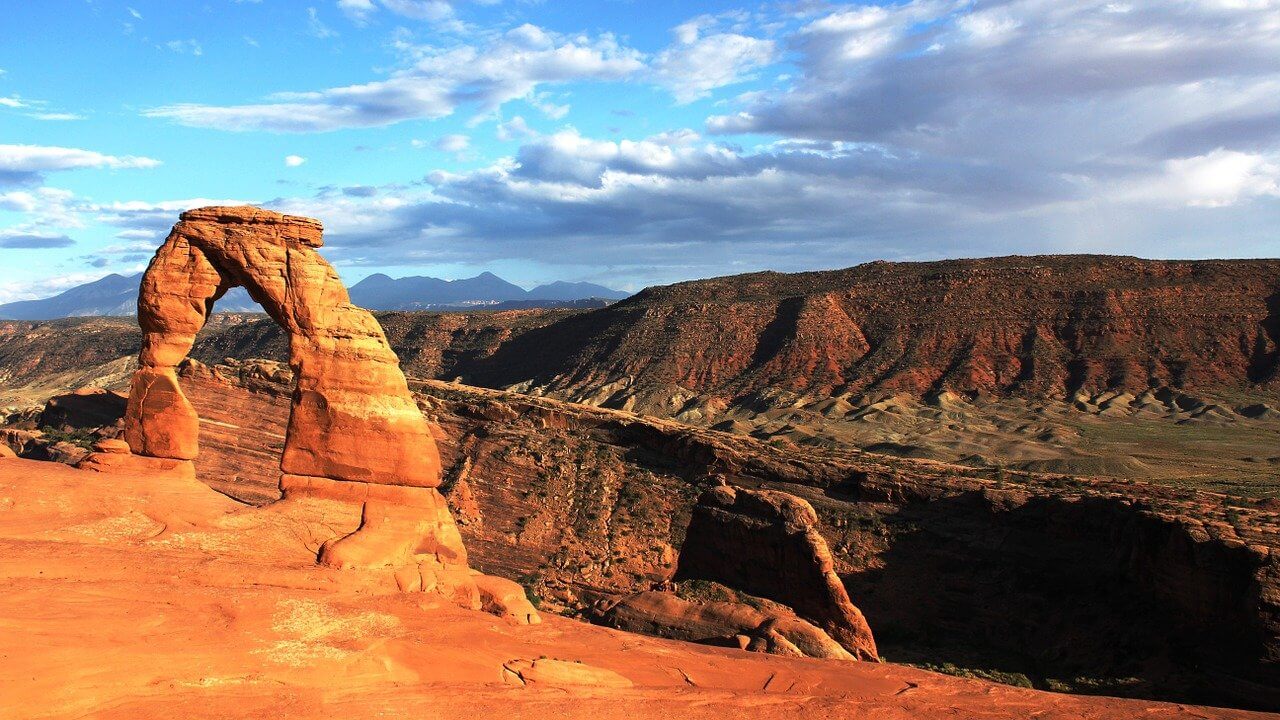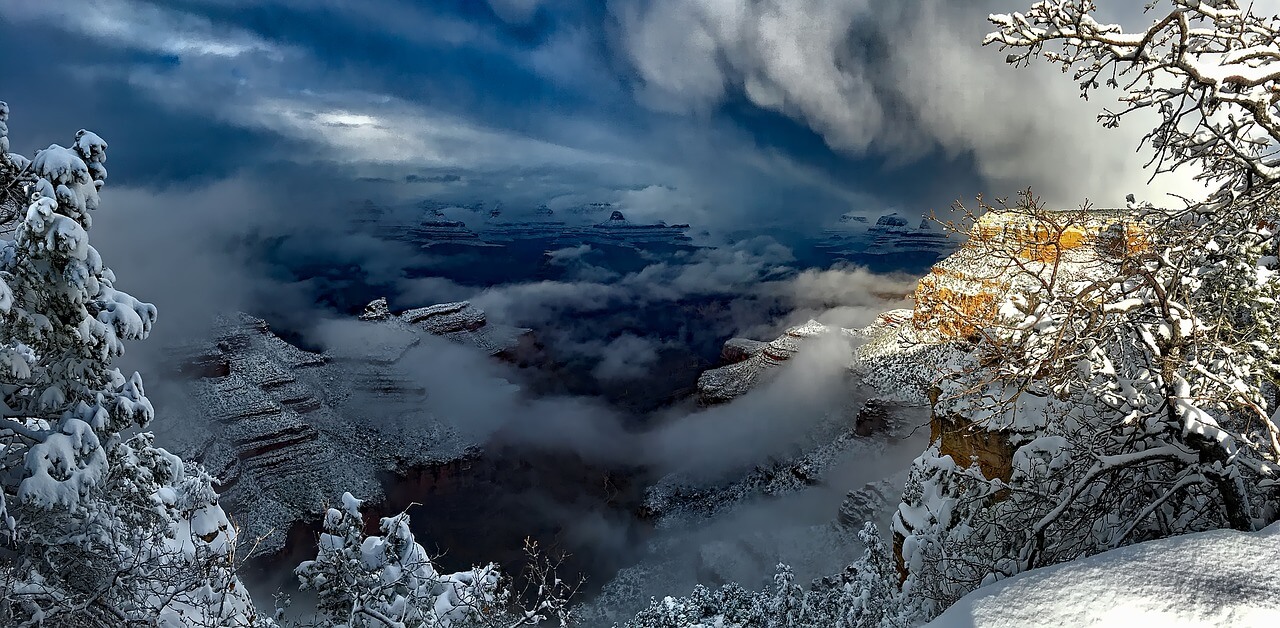Those who take trips to visit the Grand Canyon have three popular alternatives for reaching the bottom. The options are hiking, using a mule, or rafting through the Colorado River. Hiking and rafting are two popular activities in the Grand Canyon for gaining access to the bottom.

(photo depicts the Delicate Arch in Moab, Utah)
Hike to the Bottom of the Grand Canyon
If you plan to visit and hike to the bottom of the Grand Canyon, you need to know a few things before taking off.
- The hike is no small feat.
- It is a strenuous trip where adequate preparation and a high level of physical fitness are required.
- Depending on the chosen trail, the course of the hike is approximately 9.5 miles (15.5 km) from the rim to the bottom where the Colorado River is located. The elevation change is more than 4300 feet (1300 m).
- The best trails for a first-time hiker are Bright Angel or the North and South Kaibab Trails.
- For more experienced hikers, the best hikes include Mount Washburn, Seven Mile Hole Trail, Point Sublime, and the South Rim Trail.
The one-and-a-half miles of the Seven Mile Hole Trail provides a view of the Silver Cord Cascade. Travel another half mile to join the Washburn Spur Trail before arriving at the Hole a little further on the trip.
Using a Mule to Get to the Bottom of the Grand Canyon
More adventurous visitors want to create a memory of a lifetime by riding mules down into the Grand Canyon or along the rim. Two guided tours use a time-honored method of transportation with sure-footed mules. They combine the size and strength of a horse and the sure-footedness of a donkey.
Over 600,000 people took a Grand Canyon riding since they were offered in 1887. A mule ride is a rewarding and unique adventure. It is an overnight ride that goes deep into the inner Canyon. Riders stay overnight at Phantom Ranch.
There is a one-hour mule ride from the North Rim and a couple of longer mule rides that do not go to the bottom. Those tours are open in the spring, summer, and early fall, from May to October. The North Rim closes during the cold winter months.
Rafting Through the Colorado River
Two scenic drives go into the Grand Canyon to the Colorado River. One drive leads to Lee's Ferry, where rafters begin their journey through the Grand Canyon. The other curves its way through the Canyon. It starts near Peach Springs, Arizona, and follows Diamond Creek through the Hualapai Reservation.
The Grand Canyon National Park Service has helicopter tour providers certified to fly the Canyon. Tours are not allowed to fly to the bottom of the Grand Canyon's South Rim, but some tours land at the bottom of the Grand Canyon West Rim.
Camping at the Bottom of Grand Canyon
Camping underneath Grand Canyon is one of the unique experiences in America. Bright Angel camping ground provides drinking water and a toilet. Backcountry camping is also allowed for more rugged places; however, you will have to provide permits.
On a river trip, you would camp each night on the banks of the Colorado River in the base campground of the Canyon. For those who believe in the natural world, sensory overload is exciting, dizzying, enlightening, or sensory overwhelmed by sloping canyon walls. Take a look at spectacular views from the rim.
The only established campground is Bright Angel Campground. There are restrooms and drinking water available. Phantom Ranch consists of cabins not far from Bright Angel Campground. The Bright Angel has a cantina where you can get a cold beer and ice cream.
Backcountry Camping
Hundreds of hikers are saved every year near the Grand Canyon. Steep terrain, hot temperatures, and restricted water are much more dangerous than they may appear. If you are new to hiking the Grand Canyon, stick to one of the top-rated corridor trails that are more developed and popular than other hiking routes.
This trail is the best way to access the three established backcountry camping spots located in Grand Canyons. Backcountry camping entails climbing in the backcountry trail then camping in a remote wilderness area. You must get a backcountry permit to travel, but you can easily make reservations.
Hiking FAQ
Most first-time hikers walk up 2,000 meters an hour or so to the Top of the Grand Canyon. Hiking in Grand Canyon is so demanding that although people in excellent condition often get sore and exhausted. Mental health and sufficient water and food intake are necessary to succeed any hikes into the Canyon.
It can cause injury for hikers on a solo trip. The National Park Service doesn't recommend going through the rim to the river and back in a day. The South Kaibab Trail is approximately 6.6 miles to the Bright Angel Trail Campground for rest and the Bright Angel Trail.
A Grand Canyon National Park trip is the most popular hiking destination in the world. Hiking is also possible through forest trails and on the Canyon itself over various inner canyon trails. There are bicycle rentals, mule rides, camping right near the rim and the canyon floor itself, evening programs, ranger talks, buses with stops at many vantage points, and shopping in the Historic Village.
River rafting through the canyons on the Colorado River is also a must for nature enthusiasts and photographers at sunrise, evening at sunset, and after dark when the stars emerge. The most favorable time of year is between April and June. There are many dining experiences, from snack bars to exquisite dining at El Tovar Lodge Dining Room.
Advance reservations are needed for lunch and dinner. They can be made 30 days ahead. Menu features are varied and include daily specials. The menu integrates local Southwestern and International influences.
There are three ways to get to the canyon floor: walking the floor, boarding rivers, and horseback riding. If you intend to stay at Phantom Ranch, make reservations in advance. Less demanding is traveling via a mule that offers unique experiences across the nation.
With proper planning, you can feel you are floating in Grand Canyon on an adventure of a lifetime. The third method is a river raft, from a one-day excursion to epic adventures lasting three weeks or longer, some led by private outfitters or private boaters and some led by river concessions or charter groups.
The nearest airports are Flagstaff and Phoenix, Arizona 100 and 270 miles south, respectively, and Las Vegas (300 miles west). Brossman demonstrates the use of rental cars at airports for more flexibility. If you rather, you can get to the Canyon by train via the Grand Canyon railroad.
Once you are in the park, you discover the shuttle buses, excursions inside the park, bicycles, and walking paths. There is no big need for a car to reach the bottom. The ride up the track to the Grand Canyon Village depot has become one of the favorite American experiences.
If you drive, the only route that will get you to the bottom is Diamond Creek Road. It begins at Peach Springs, a town in Arizona on the historic Route 66. For a journey with Diamond Creek through the Great Canyon, you will need a driver's license because the road is located on Hualapai tribal land.
It can take as much as an hour to complete the road trip to the bottom that starts at the Hualpai Lodge. To correctly enter the route requires a well-geared vehicle such as a high-performance 4x4. When you approach the bottom of the Colorado River, many streams cross the Diamond River.
The depth to the bottom of the Grand Canyon, it is 6,000 feet deep, which reaches its deepest point. It holds the fifth position on the list of the deepest canyons. Going the course to the bottom of the Grand Canyon might last you up to 12 miles or 16 km, depending on how much trail you choose.
The best option is to find beautiful accommodations down the Canyon and rest there before reaching the Top. It can five hours to get to the Canyon's floor with an elevation change of 4.300 feet (1310 meters).
Making reservations at the Phantom Ranch is not easy. It has limited availability and many people who want to stay there. Reservations are cabins made through a lottery system. Contact the Central Reservation agents at 888-297-2757. They are open from the hours of 7 am to 7 pm Mountain Time.
An alternative location to the Phantom Ranch is the Bright Angel Lodge and Cabins located at the top of the trail. There are 90 units there. People visit from all over the world. These cabins have no air conditioners for times when temperatures during the year are high.
Ideal weather conditions in the Grand Canyon are between April and June. Temperatures have not reached their scorching highs, and rainfall averages are low.
The Inner Canyon Tour is an adventure where guests board a van or coach. As they relax in comfortable, spacious seats, they travel along a remaining stretch of the Historic Route 66 to Peach Springs, Arizona, in the Hualapai Nation. From there, they descend to the bottom of the Grand Canyon.


 (photo depicts the Delicate Arch in Moab, Utah)
(photo depicts the Delicate Arch in Moab, Utah)


